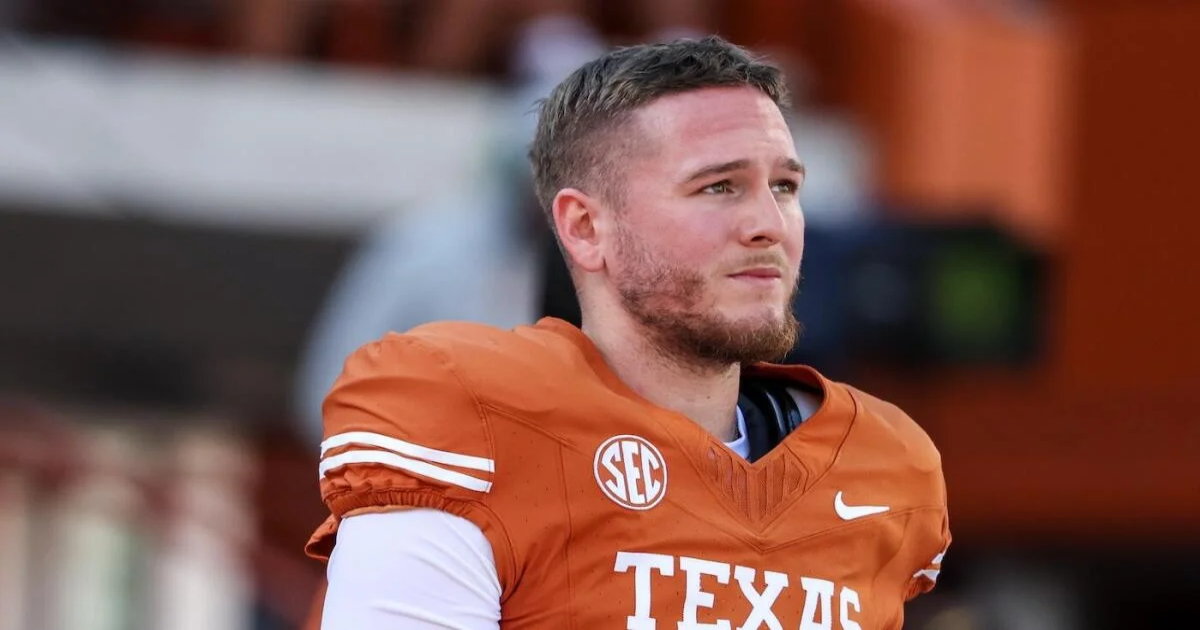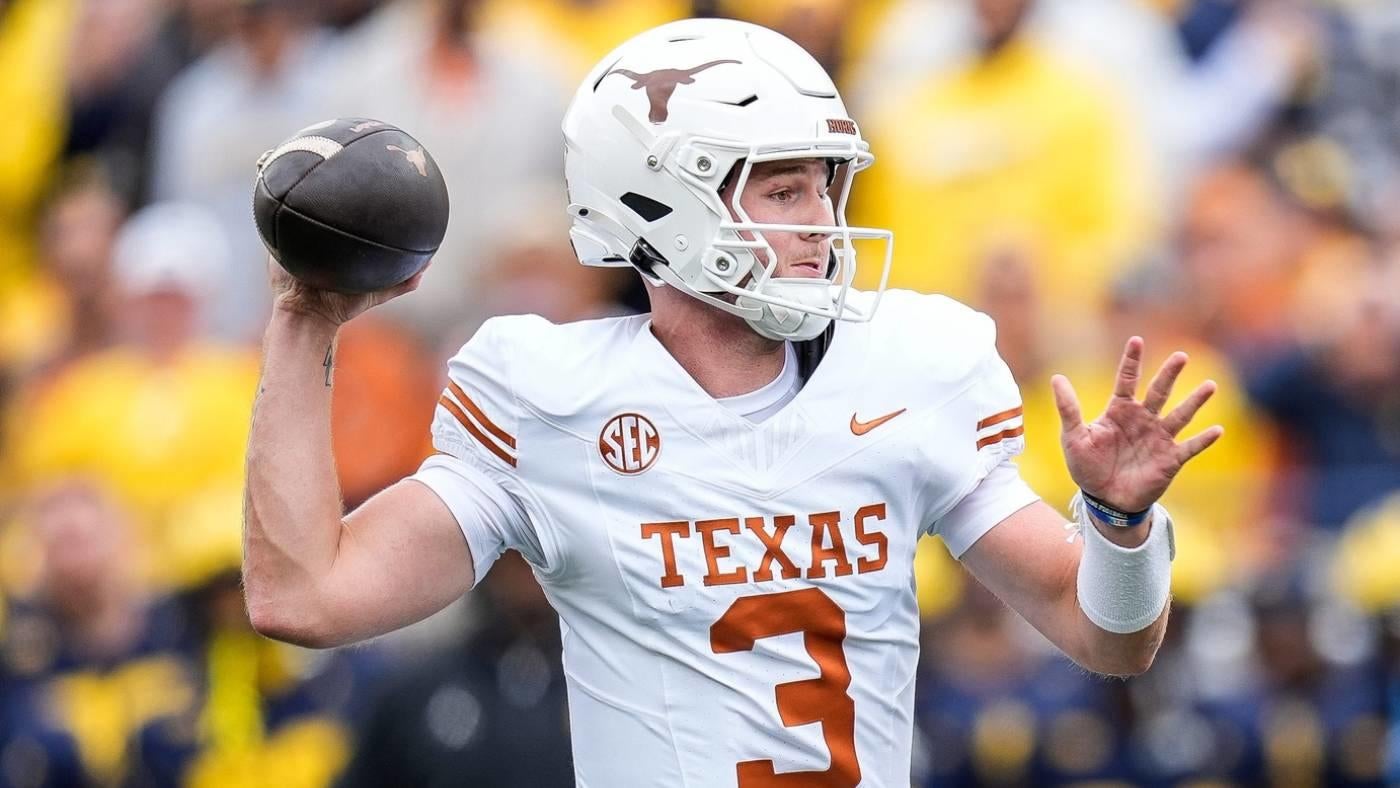
Getty Images
Four years later, it’s hard to remember just how heralded Quinn Ewers was as a recruit. He became the first recruit at any position since 2016 to earn a perfect 1.0000 rating in the 247Sports composite, and joins Longhorns legend Vince Young as the only quarterback to hit the mark in the metric’s history (since 2000). When he decommitted from Texas in October 2020, it was the final nail in the coffin for Tom Herman, who was fired shortly thereafter.
Ewers was so highly regarded that he reclassified so he could collect a seven-figure NIL contract a year early. No matter, he went from the No. 1 player in 2022 to the No. 1 player in 2021. Ewers used the most exclusive quarterback room in America, Ohio State, as a de facto study abroad program before ultimately ending up in Austin as Steve Sarkisian’s protégé.
On Saturday, his college story ended with the 231st pick of the seventh round of the 2025 NFL Draft. He was 14th out of 14 quarterbacks selected, behind even FCS quarterbacks Tommy Mellott and Cam Miller. It was not the finish anyone expected for one of the most high-profile quarterback recruits in the history of the sport.
How did we get here, from No. 1 overall recruit to the seventh round? It’s a complicated story filled with the trappings of this era, injuries and the battle between cash grabs and legacy that makes him a case study in the impossible decisions asked of quarterbacks in this moment.
Reclassification saga
The first time I watched Ewers play live was during the 2020 Texas Class 6A-D1 State Championship Game. Ironically, he played for Southlake Carroll against Clemson‘s Cade Klubnik, who went on to become the No. 1 quarterback in the 2022 class after Ewers reclassified. Even competing against another highly ranked QB while dealing with injuries during a loss, Ewers was a man among boys. He threw for 350 yards against one of the top defenses in state history.
What no one realized at the time was that they were watching Ewers’ final high school football game. Instead of riding into his senior year under heralded quarterback developer Riley Dodge, he suddenly reclassified so he could pursue seven figures in NIL deals, primarily with a kombucha company. He arrived on campus in August before the season after not going through either spring or summer drills. Ohio State made clear that they weren’t thrilled about the timing but still took him for his prodigious talents.
There was little opportunity for Ohio State to dedicate any real development time to Ewers with C.J. Stroud, Kyle McCord and Jack Miller already on campus. Instead, Ewers essentially came, drove a massive truck he received through an NIL contract, collected checks, and then transferred to Texas. Ewers also benefitted from the NCAA’s new rule that allowed players to transfer without sitting out, so he could leave immediately and start.
Did Ewers stunt his development by leaving a quarterback development factory in Southlake to be an afterthought in Columbus? Not necessarily, but it likely didn’t help.
Injury woes
Even dating back to high school, Ewers struggled to stay healthy. He dealt with a core issue during his final high school season that cost him multiple games. After winning the starting job at Texas, he dealt with injury issues each of his three years.
Ewers suffered major sprains of his SC joint (2022) and AC joint (2023) in his shoulders that cost him multiple games. In 2024, the core issues popped up again after a non-contact abdominal strain against UTSA. His efficiency fell from Year 2 to Year 3 after playing through some of the discomfort.
Overall, Ewers missed seven starts across three years, which opened the door for Arch Manning, Maalik Murphy and Hudson Card to start in his wake. Ewers always fought back — his toughness was never appreciated enough — but it remains unclear how much the injuries have to do with losing some of the zip and accuracy he displayed during his sensational high school career.
For many college football fans, it was confusing that Ewers was ever considered such a can’t-miss prospect with his limitations. Go watch his high school tape. It wasn’t always that way.
Manning’s arrival at Texas
Ewers is one of the most touted quarterback recruits in the history of the sport. Unfortunately for him, his college career was often defined by one of the few who surpass him: Arch Manning, who was also a No. 1 overall quarterback recruit for 2023, but with the most famous name in football on his back. Whereas some wanted Ewers to see playing time at Ohio State when Stroud struggled early, the noise for Manning was raucous from the start.
Sarkisian handled the situation about as well as possible. From the start, he was clear: Ewers was the starting quarterback. That was echoed by both Ewers and Manning, along with every other member of the team. Still, almost every week involved at least some question about the famous last name.
There were moments when the pressures of having a famous backup QB clearly impacted Ewers. He was pulled for a few drives near halftime of the 2024 Georgia game. Though he looked rattled on the sideline, Ewers came back in and played better. He also rushed back from his abdominal injury and never truly looked healthy.
Most teams would take a fourth season from a two-time all-conference quarterback. That was never the case at Texas. The Manning era starts now.
Ewers’ legacy
Ewers potentially left millions of dollars on the table by turning down the transfer portal and entering the NFL Draft. Notre Dame and Miami were among the programs that reportedly did their homework on Ewers before he opted to turn pro. There’s no sugarcoating it: there’s a real chance that Ewers never makes that much money for the rest of his life.
Despite his draft slot, Ewers had a tremendously successful college career. He led Texas to back-to-back national semifinals, the only team to accomplish the feat each of the past two seasons. Both times, they were one play away from making the national title game. The program had a top-five finish drought dating back to 2009, and Ewers led the Horns there in each of his last two seasons. Ewers threw for 9,128 yards and 68 touchdowns on 64.9% completion in three seasons — outstanding numbers for any pedigree.
Frankly, there’s something to be said for leaving college football when it’s time. Ewers started three years at a blue-blood school and leaves as one of the top five greatest quarterbacks in the history of the program, behind only Colt McCoy and Vince Young post-integration. In an era when players are ruining legacies to chase short-term money, Ewers was even more valuable. Young, for example, has been hired multiple times as an athletic department ambassador. Ewers could easily go down a similar path with his reputation in Austin.
If anything, Ewers’ decision to move on from college to the NFL without any guarantees is an emblem of how much he’s grown over the past four years. With the Miami Dolphins, Ewers finds a solid fit and a realistic chance to grow into a rostered quarterback behind Tua Tagovailoa and Zach Wilson. If it doesn’t work out, he’ll head into the world with a few million dollars in his bank account and the support of the UT network behind him.
Still, Ewers’ arc will be an instructive one about the complications of the modern era of being a college quarterback. Stock rises and falls faster than anyone can imagine — even for the No. 1 quarterback in the country.


